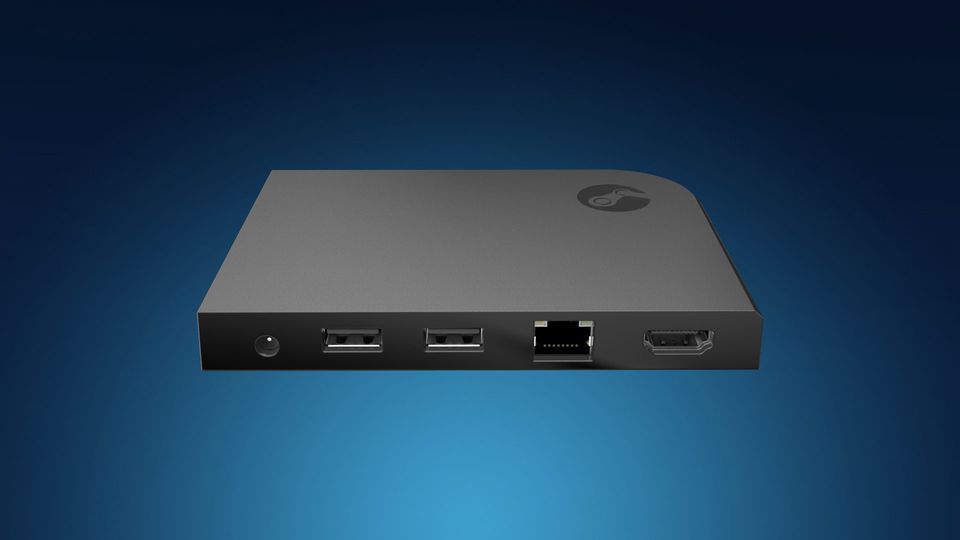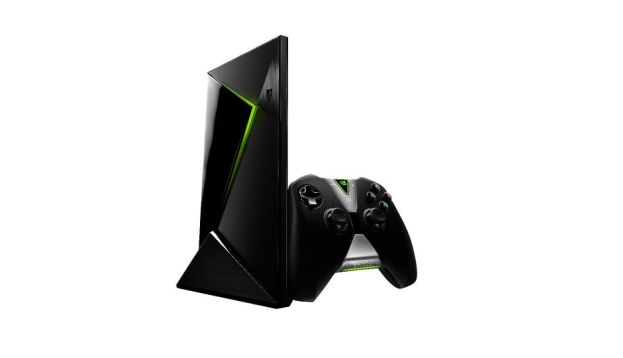The second day of GDC has seen several important hardware announcements that show us a possible new front in the console wars, pitting consoles directly against PCs for dominance of the living room. Not only that, Sony provided more information about Project Morpheus, and their immersive VR headset may well be an important part of Sony’s fight to stay in first place in the console race.
First off, let’s start with Valve, who announced a key piece of new hardware: the Steam Link, a $49.99 box that will bring your PC’s output to any TV in your house. Valve’s press release gives few details: “Designed to extend your Steam experience to any room in the house, Steam Link allows you to stream all your Steam content from any PC or Steam Machine on the same home network. Supporting 1080p at 60Hz with low latency, Steam Link will be available this November for $49.99, and available with a Steam Controller for an additional $49.99 in the US (worldwide pricing to be released closer to launch).”
Valve also promised Steam Machines from a variety of partners for later this year, though few details were provided. “Steam Machines from partners Alienware and Falcon Northwest are being shown, with Machines from a dozen other partners slated to release this November. Steam Machines will start at the same price point as game consoles, with higher performance. Customers interested in the best possible gaming experience can choose whichever components meet their needs. Epic will give a demonstration of the newly announced Unreal Tournament running on a 4K monitor driven by the Falcon Northwest Steam Machine.”
“We love this platform,” said Tim Sweeney, founder of Epic Games. “Whether you’re running incredibly detailed scenes at 4K or running 1080p at 120 FPS for an intense shooter experience, this brings world-class gaming and graphics to televisions with an open platform true to Valve’s PC gaming roots.”
Looking more closely at this information, one can see that Valve is attacking the current console market on two fronts. The Steam Link is arguably the most important part of this announcement, allowing PC gamers to bring the PC game into the family room in direct competition with consoles for less than $100 (counting both the Steam Link and the Steam Controller). That’s a very reasonable price compared to buying a new console… if the Steam Controller can really give you a good experience with your favorite PC game, that is. Certainly some games will work well with a Steam Controller, but it’s hard to see how games like League of Legends or World of Warcraft would fare without a keyboard and mouse, no matter how good Steam Controllers end up being.
 Steam Link
Steam Link
The second front is a direct competition with the Xbox One and PS4, promising even higher performance at the same price. That shouldn’t be hard to achieve, given that PC graphics continue to advance while the consoles remain static. Again, though, the question becomes what games will be available, and how good will they be The same game you can play on a console with slightly better graphics doesn’t seem like enough reason to buy a Steam Machine, particularly if you already have a console. Like other consoles, Steam Machines will benefit from exclusives — and an exclusive title that would really drive sales is critical. Half-Life 3, for instance, could be such a title… yet we still have no word of such a thing. Get busy, Valve!
Meanwhile, the console market is under direct assault from another direction, as Nvidia announces two killer technologies: the new Nvidia Shield console. It’s an Android console powered by the new Tegra X1 chip, and Nvidia CEO Jen-Hsun Huang introduced it as being twice the power of an Xbox 360 at half the power consumption. It’s “the world’s first 4K Android TV console” and it will launch in May for $199, game controller included. Nvidia Shield will have its own store, and at the time of launch there’ll be over 50 games curated, according to Huang. Demoed on-stage were Portal, Star Wars: Knights of the Old Republic, and Half-Life 2: Episode 1. Multiple developers were on hand to show support and live demos, including Gearbox Software’s Randy Pitchfork (for Borderlands: The Pre-Sequel, running at 30fps), id’s Tim Willits (Doom 3 BFG edition), and Crytek’s Cevat Yerli (Crysis 3 at 30fps).
And if that’s not enough, the Nvidia Shield console launches along with Nvidia’s new game-streaming service Grid, which will be streaming top-tier game titles at up to 1080p and 60 frames per second. The Grid service is backed by Nvidia Grid supercomputers worldwide and Amazon Web Services, and can stream at 150ms, or “half a blink of an eye.” Nvidia will offer two tiers of Grid service. The free subscription service has 50+ games, while the premium will reportedly let you buy titles à la carte (like Batman: Arkham Knight for $59.99). Huang says many titles will be on the service day and date with their release.
We see from this that Nvidia is dead serious about the console market, taking aim at the leading players by delivering a two-pronged punch. The Nividia Shield console seems to be able to deliver solid console games comparable to what’s available on the Xbox One and PS4 at only $199. More than that, the Grid streaming service promises to deliver top-notch PC games to the living room at solid resolution and frame rates — though again the controller issue raises its ugly head. Standard controllers or even slightly fancy ones can’t really do justice to PC games. So far, Razer seems to be the only Android TV entrant that has addressed this issue head-on, with a keyboard and mouse combo designed for the living room to accompany their upcoming Forge console (which, as a reminder, also features streaming from your home PC).
This is setting up a massive battle in the fall between Android TV devices like the Razer Forge and Nvidia Shield, the Steam Link and Steam Machines, and the PS4, Xbox One, and the Wii U, though the selection of games on the Wii U is so utterly different from everything else as to make it not in direct competition with these other devices. ONe key thing about the Nvidia Shield: It will stream and display 4K vidoe, something neither the PS4 nor the Xbox One can do. As 4K TVs become more prevalent (with prices rapidly dropping), this will become a more important feature.
Sony is apparently unwilling to cede its console leadership (announced today to be 20.2 million PS4 consoles sold through worldwide to date) by announcing that its Project Morpheus immersive VR headset, designed to connect to the PS4, will ship in the first half of 2016. Morpheus is designed to render games at 120 frames-per-second. This will work in concert with a “super low” latency of 18ms, or around half that of the original Morpheus prototype. The first prototype’s 5-inch LCD screen has been swapped 5.7 inch 1920 X 1080 resolution OLED display, with RGB sub-pixels to reduce motion blur. Positional tracking has been improved with the addition of three new LEDs to its existing six – one on the front and two on the sides. Sony has promised to reveal more details, including new games, at E3.
Make no mistake, the marketing warfare in the fall promises to be huge. The console fight is becoming ever more interesting, with many more players. There’s still the spectre of Apple looming, if it ever decides to upgrade the Apple TV into a serious gaming device. Don’t expect Microsoft or Nintendo to take any of these lightly, either. It’s going to be a lot harder to succeed with hardware this year, but it’s looking like a great time to be a gamer.

